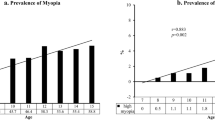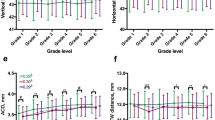Abstract
Purpose
To determine the prevalence of and risk factors for myopia in primary school children in Chaoyang District, Beijing.
Methods
This cross-sectional prevalence survey was conducted in September to October 2011 in 4 schools randomly chosen from among the 126 primary schools in Chaoyang District. Students were assessed with autorefractometry under cycloplegia and checked with retinoscopy for accuracy. Questionnaires were completed by the students’ parents.
Results
Myopia was present in 36.7 ± 0.7 % of 4249 students aged 5–14 years old. The prevalence of myopia in girls (38.6 ± 1.1 %) was significantly higher than in boys (35.0 ± 1.0 %) (p = 0.015) and increased with age (p < 0.001), with the highest prevalence observed in children aged ≥11 years (67.5 ± 1.8 %). After adjustment, having a myopic parent (aOR 3.10; 95 % CI 2.49–3.86), incorrect reading posture (aOR 2.09; 95 % CI 1.75–2.50), reading a book at a distance of <20 cm (aOR 1.60; 95 % CI 1.16–2.21), studying at home for >3 h daily (aOR 1.50; 95 % CI 1.12–2.01), studying for >1 h continuously (aOR 1.21; 95 % CI 1.02–1.45), and reading extracurricular books that utilize a font larger than that used in textbooks (aOR 0.74; 95 % CI 0.59–0.94) were all significantly associated with myopia.
Conclusions
The prevalence of myopia among primary school children in Beijing increased with age, and was significantly higher in girls ≥10 years old. Myopia was significantly associated with parental myopia, reading posture, distance between the eyes and the book being read, font size used in extracurricular reading material, time spent studying at home, and the duration of continuous study time.

Similar content being viewed by others
References
Congdon NG, Friedman DS, Lietman T. Important causes of visual impairment in the world today. JAMA. 2003;290:2057–60.
Zadnik K. The Glenn A. Fry Award Lecture (1995): Myopia development in childhood. Optom Vis Sci. 1995;1997(74):603–8.
Vitale S, Sperduto RD, Ferris FL III. Increased prevalence of myopia in the United States between 1971–1972 and 1999–2004. Arch Ophthalmol. 2009;127:1632–9.
Matsumura H, Hirai H. Prevalence of myopia and refractive changes in students from 3 to 17 years of age. Surv Ophthalmol. 1999;44(Suppl 1):S109–15.
Lam CS, Goldschmidt E, Edwards MH. Prevalence of myopia in local and international schools in Hong Kong. Optom Vis Sci. 2004;81:317–22.
Xie HL, Xie ZK, Ye J, Yang XJ, Qu J. Analysis of correlative factors and prevalence on China’s youth myopia. Zhonghua Yi Xue Za Zhi. 2010;90:439–42.
He M, Zeng J, Liu Y, Xu J, Pokharel GP, Ellwein LB. Refractive error and visual impairment in urban children in southern China. Invest Ophthalmol Vis Sci. 2004;45:793–9.
He M, Zheng Y, Xiang F. Prevalence of myopia in urban and rural children in mainland China. Optom Vis Sci. 2009;86:40–4.
Lim LT, Gong Y, Ah-Kee EY, Xiao G, Zhang X, Yu S. Impact of parental history of myopia on the development of myopia in mainland China school-aged children. Ophthalmol Eye Dis. 2014;6:31–5.
Mutti DO, Mitchell GL, Moeschberger ML, Jones LA, Zadnik K. Parental myopia, near work, school achievement, and children’s refractive error. Invest Ophthalmol Vis Sci. 2002;43:3633–40.
You QS, Wu LJ, Duan JL, Luo YX, Liu LJ, Li X, et al. Factors associated with myopia in school children in China: the Beijing childhood eye study. PLoS One. 2012;7:e52668.
Morgan IG, Ohno-Matsui K, Saw SM. Myopia. Lancet. 2012;379:1739–48.
Saw SM, Zhang MZ, Hong RZ, Fu ZF, Pang MH, Tan DT. Near-work activity, night-lights, and myopia in the Singapore–China study. Arch Ophthalmol. 2002;120:620–7.
Donovan L, Sankaridurg P, Ho A, Chen X, Lin Z, Thomas V, et al. Myopia progression in Chinese children is slower in summer than in winter. Optom Vis Sci. 2012;89:1196–202.
Lin Z, Vasudevan B, Jhanji V, Mao GY, Gao TY, Wang FH, et al. Near work, outdoor activity, and their association with refractive error. Optom Vis Sci. 2014;91:376–82.
Xiang F, He M, Morgan IG. The impact of parental myopia on myopia in Chinese children: population-based evidence. Optom Vis Sci. 2012;89:1487–96.
Pizzarello L, Abiose A, Ffytche T, Duerksen R, Thulasiraj R, Taylor H, et al. VISION 2020: the right to sight: a global initiative to eliminate avoidable blindness. Arch Ophthalmol. 2004;122:615–20.
Fan DS, Lam DS, Lam RF, Lau JT, Chong KS, Cheung EY, et al. Prevalence, incidence, and progression of myopia of school children in Hong Kong. Invest Ophthalmol Vis Sci. 2004;45:1071–5.
Saw SM, Katz J, Schein OD, Chew SJ, Chan TK. Epidemiology of myopia. Epidemiol Rev. 1996;18:175–87.
He M, Huang W, Zheng Y, Huang L, Ellwein LB. Refractive error and visual impairment in school children in rural southern China. Ophthalmology. 2007;114:374–82.
Lim HT, Yoon JS, Hwang SS, Lee SY. Prevalence and associated sociodemographic factors of myopia in Korean children: the 2005 third Korea National Health and Nutrition Examination Survey (KNHANES III). Jpn J Ophthalmol. 2012;56:76–81.
Ip JM, Saw SM, Rose KA, Morgan IG, Kifley A, Wang JJ, et al. Role of near work in myopia: findings in a sample of Australian school children. Invest Ophthalmol Vis Sci. 2008;49:2903–10.
Yip VC, Pan CW, Lin XY, Lee YS, Gazzard G, Wong TY, et al. The relationship between growth spurts and myopia in Singapore children. Invest Ophthalmol Vis Sci. 2012;53:7961–6.
Jones LA, Sinnott LT, Mutti DO, Mitchell GL, Moeschberger ML, Zadnik K. Parental history of myopia, sports and outdoor activities, and future myopia. Invest Ophthalmol Vis Sci. 2007;48:3524–32.
Saw SM, Nieto FJ, Katz J, Schein OD, Levy B, Chew SJ. Familial clustering and myopia progression in Singapore school children. Ophthalmic Epidemiol. 2001;8:227–36.
Wong TY, Foster PJ, Hee J, Ng TP, Tielsch JM, Chew SJ, et al. Prevalence and risk factors for refractive errors in adult Chinese in Singapore. Invest Ophthalmol Vis Sci. 2000;41:2486–94.
Mutti DO, Zadnik K. Has near work’s star fallen? Optom Vis Sci. 2009;86:76–8.
Paudel P, Ramson P, Naduvilath T, Wilson D, Phuong HT, Ho SM, et al. Prevalence of vision impairment and refractive error in school children in Ba Ria—Vung Tau province, Vietnam. Clin Exp Ophthalmol. 2014;42:217–26.
Demirci G, Arslan B, Özsütçü M, Eliaçık M, Gulkilik G. Comparison of photorefraction, autorefractometry and retinoscopy in children. Int Ophthalmol. 2014;34:739–46.
Acknowledgments
This study was funded by the China Health and Medical Development Foundation. The authors would like to thank the members of this study team and the participating schools, pupils, and parents. The authors would also like to thank Zhenying Li from the Chaoyang Center for Disease Control and Prevention, Beijing, China, and Ping Zhang from the Chaoyang Health Care Institution for students in Middle and Primary School, Beijing, China, for their hard work in collecting data. Editorial assistance during the preparation of this article was provided by Dr. Ruth Warre.
Conflicts of interest
Y. Lyu, None; H. Zhang, None; Y. Gong, None; D. Wang, None; T. Chen, None; X. Guo, None; S. Yang, None; D. Liu, None; M. Kang, None.
Author information
Authors and Affiliations
Corresponding author
About this article
Cite this article
Lyu, Y., Zhang, H., Gong, Y. et al. Prevalence of and factors associated with myopia in primary school students in the Chaoyang District of Beijing, China. Jpn J Ophthalmol 59, 421–429 (2015). https://doi.org/10.1007/s10384-015-0409-x
Received:
Accepted:
Published:
Issue Date:
DOI: https://doi.org/10.1007/s10384-015-0409-x




